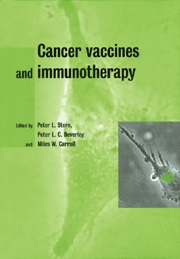Book contents
- Frontmatter
- Contents
- List of contributors
- 1 Immunity and cancer
- 2 Immunotherapy of bladder cancer
- 3 Poxviruses as vectors for cancer immunotherapy
- 4 Vaccinia-based human papillomavirus vaccines in cervical cancer
- 5 Vaccine delivery and immunosuppression in cervical cancer
- 6 Vaccines for colon cancer
- 7 MUC1 vaccines and breast cancer
- 8 Anti-idiotypic vaccination
- 9 Immunotherapy and vaccination against Epstein–Barr virus-associated cancer
- 10 Serologically identified tumour antigens as cancer vaccines
- 11 CTL-defined cancer vaccines in melanoma and other epithelial cancers
- 12 DNA vaccines against B-cell tumours
- 13 Dendritic cell approaches to immunotherapy
- 14 Overview
- 15 Recent developments
- Index
9 - Immunotherapy and vaccination against Epstein–Barr virus-associated cancer
Published online by Cambridge University Press: 06 January 2010
- Frontmatter
- Contents
- List of contributors
- 1 Immunity and cancer
- 2 Immunotherapy of bladder cancer
- 3 Poxviruses as vectors for cancer immunotherapy
- 4 Vaccinia-based human papillomavirus vaccines in cervical cancer
- 5 Vaccine delivery and immunosuppression in cervical cancer
- 6 Vaccines for colon cancer
- 7 MUC1 vaccines and breast cancer
- 8 Anti-idiotypic vaccination
- 9 Immunotherapy and vaccination against Epstein–Barr virus-associated cancer
- 10 Serologically identified tumour antigens as cancer vaccines
- 11 CTL-defined cancer vaccines in melanoma and other epithelial cancers
- 12 DNA vaccines against B-cell tumours
- 13 Dendritic cell approaches to immunotherapy
- 14 Overview
- 15 Recent developments
- Index
Summary
Introduction
Epstein–Barr virus (EBV) is a member of the Herpes family of viruses and infects the human population worldwide. In the 35 years since its discovery, EBV has attracted ever-increasing attention from medical, molecular biological, virological and epidemiological viewpoints. It is one of the most efficient cellular growthtransforming viruses known and yet, following natural primary infection during childhood, it generally coexists within its host completely asymptomatically and, in common with other herpesviruses, establishes a persistent infection which is maintained lifelong. In Western communities about 85–90% of all adults carry the virus, whereas in developing countries the infection level approaches 100% by the age of two. At any given time, about 20% of virus-positive individuals shed infectious virus in saliva which is believed to form the primary route of transmission. However, under certain circumstances its pathogenic potential is unleashed and EBV is associated with a wide spectrum of clinical conditions, many of which are malignant.
Clinical significance of EBV
In developed countries primary infection is often delayed for several years. Following first time infection during adolescence or young adulthood, clinical infectious mononucleosis (IM) develops in about half of the instances. In the United States alone, it is estimated that there are about 100000 new cases per year. However, despite the significant morbidity which is directly attributable to the aetiological role of EBV in the causation of IM, it is more the virus' associations with various human cancers which are the prime considerations behind the need for vaccination and/or therapy.
- Type
- Chapter
- Information
- Cancer Vaccines and Immunotherapy , pp. 174 - 194Publisher: Cambridge University PressPrint publication year: 2000
- 1
- Cited by



